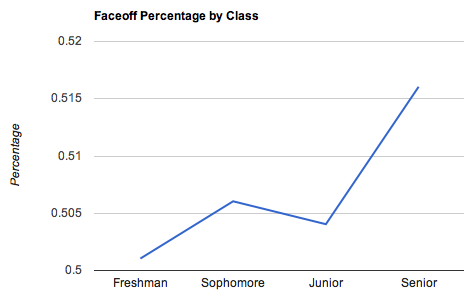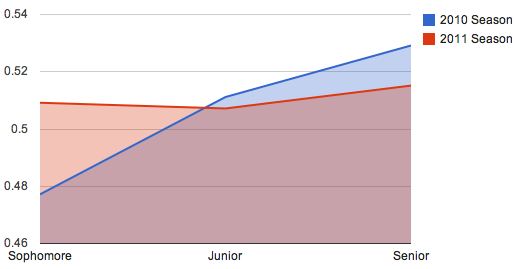This post was a lot more work than it’s ultimately going to be worth, I think. I decided to take a look at every player who took faceoffs in Division-1 lacrosse last year, in order to see a few things:
- Is there a trend from year-to-year in any class being good at faceoffs?
- Do individual faceoff specialists tend to improve from year-to-year?
- Is there even enough data to determine either of the previous things on the whole?
- On the same note, is it predictive for the future, or seemingly random?
There were a few problems with my data collection. You’ll notice that the faceoff percentages for every class are better than 50%. This is statistically impossible, of course, and there are a couple reasons for this: I didn’t include Presbyterian (their school’s website has already removed the lacrosse statistics, as the sport has been discontinued) or Mercer (as a first-year program, their stats were also terrible, but I didn’t include them), and I also probably missed a few 0-6 and 0-8 players at various schools, since those stat lines look shockingly similar to 0-0.
Anyway, you can see the full data on this Google Doc. For the over-arching points, here is the first graph:
It depicts the faceoff win percentage for each class (as listed on team rosters, pulled from team statistics). As you can see, the seniors were by far the best in 2011, and there does seem to be a trend of improvement as time goes on (though the juniors were worse than sophomores). A few hypotheses as to why that’s the case:
- Faceoff specialists simply get better with more experience.
- A lot of frehsmen try their hand at faceoffs, and once they prove to be bad, they don’t get opportunities in subsequent years (that freshman class had by far the highest number of players who had attempted a faceoff, supporting this reasoning).
- Simple statistical anomaly. With only four data points, and an imperfect trend, this could also be the case.
As a follow-up, I decided to see if individual players improve from year-to-year. Since some schools have horrible websites that don’t make archived statistics available, this is becoming even less of a perfect science. However, every individual (on a team for whom I could find 2010 AND 2011 statistics) that took faceoffs in both of the past two years is included:
(Classes are their 2011 standing, they were obviously a year younger in 2010). As you can see, players improved from freshman year to sophomore year, but they actually got worse on the whole going into their junior and senior years. There are also some plausible explanations for this:
- Some good faceoff men stop taking draws as they become more important pieces of the team offense and/or defense.
- Some good faceoff men perform worse (while still taking draws) as they play a bigger role in the offense and/or defense, due to fatigue.
- There’s just no reason to expect improvement from year-to-year, and it’s a statistical anomaly.
- Sample size difference from graduating players (or incoming players) in other classes make good/bad players take a different number from year-to-year, skewing the statistics.
Of course, there are several individuals that got worse (and some got a lot better) from year-to-year, and there is also an argument that some schools are better at developing faceoff men than others. Johns Hopkins and Bucknell, for example, saw every player who fits our criteria improve from 2010 to 2011. Detroit, on the other hand, saw every single player get worse on faceoffs over the past two seasons (uh oh, since I originally started this post to explore UDM’s faceoffs and their potential to improve next year).
Of course, at the end of the day, there are so many factors going into faceoffs – competition, wing play, faceoff style, etc. – that make this data inconclusive at best. My takeaway from the entire exercise is that there’s no reason to expect, on aggregate, an improvement from year-to-year for an individual faceoff specialist.



Pingback: UDM Improvement ’12: Faceoffs | Great Lax State
Pingback: Michigan Fall Ball Preview: Towson | Great Lax State
Pingback: Detroit Fall Ball Preview: Denison | Great Lax State
Pingback: Ohio State 11, Detroit 6 | Great Lax State